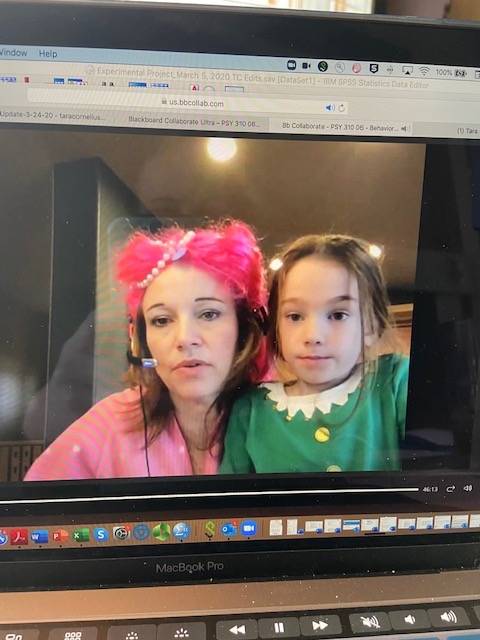CLAS Acts April 2020
Monthly newsletter of the TT CLAS Faculty


Timely Structure and Asynchronous Compassion
By Monica Johnstone, PhD
With the transition to asynchronous provision of teaching online on faculty’s minds, it seemed the perfect time to catch up (remotely) with Jodee Hunt (BIO) and Tara Cornelius (PSY) to find out how they have been making this work for their students.
In our Monday Zoom meeting (my first), Jodee stressed to me that her approach is not a wide variety of software packages and glittering video. In fact, she tends to stick to what Blackboard can do natively.
“These are simple Blackboard features that I’d been using anyway,” Jodee explained. “I even felt a little guilty that is wasn’t more high tech, but students actually liked that I stuck to what they know.”
In fact, there are no videos of Jodee teaching in her course. She is making use of animal behavioral videos that are readily available and have proved great alternatives to longer ones she has used in the past. “These are shorter and funnier.”
Jodee relies primarily on written notes and handouts which her students tell her they often prefer to video because they can read them at their own pace and that helped them do their best.
“Readings, study guides, handouts are now more comprehensive. When using written materials in an online class, there is one big caveat—clarity, clarity, clarity! I spend hours editing them so that they are simple, clear, and well organized.” She says this becomes particularly important when it comes to any changes in the syllabus, any adjustments to the point value of an assignment, because students are anxious and are quick to pick up on anything that seems to be an anomaly on the Blackboard Grade Center. Avoiding these momentary freak outs through extra attention to being clear has helped.
Jodee’s students report to her that while some like synchronous learning which provides structure to their day, others really need to be able to work asynchronously.
“In my Announcements, I’ve been including notes to be well and get outside. Acknowledging the stress and asking if they need access to anything seems to be appreciated even more than I anticipated. I get almost daily notes saying, ‘thank you so much for caring’. A follow up on a sick grandfather is especially appreciated now,” Jodee observes.
Late last week, Tara Cornelius and I “met” by a combination phone and email over a couple days. I was still awaiting the arrival of my camera and was not yet set up for video-conferencing. It was a reminder of the different levels of readiness we each had for the fast transition to working remotely.
Tara wrote, “This process of transitioning to remote learning was an emergency effortꟷ it was triage teaching. So it was nowhere near the thoughtful development of online delivery of courses that I aspire to, and I cannot say that I thoughtfully identified goals in those first four days of frantic preparation. However, looking retrospectively at my approach after a few weeks of remote teaching, I would say that I aspire to balance structure and flexibility, intermixed with some compassion.”
Since her field is Psychology, it was not lost of Tara that structure provides students some stability, normality, and continuity. To create this stability, Tara implemented consistent, weekly deadlines, and similarities in tasks for each week: read the assigned reading, watch the pre-recorded video lecture, attend virtual class at your typical class-time, and complete an assignment or assessment.
“The flexibility is important in that students’ lives are changed right nowꟷ things are chaotic, and the demands on their cognitive and psychological resources are varied and many. So students can come to the course material whenever it works in their life, complete assignments on their own time. Although classes are offered at their regularly scheduled times, I record these and send them to all students so they can watch those at any time, even if they cannot attend class in the traditional sense.”
Like Jodee, Tara sees the need for more overt compassion in these suddenly online courses. “Compassion has become even more central to my approach. Students, all of us really, are facing numerous demands from a myriad of sources, and these have all collided at the same unprecedented moment in timeꟷ instability, perhaps economic and housing disruptions, additional demands on their time including childcare and caring for others, potentially serious illness, the very real psychological effect of the unknown and capricious nature of this virus, combined with potentially limited access to social support. While in a given semester these stressors may be present for individual students, this has all come to the forefront for all of us. And I sometimes see objective signs of this, including children and others coming into the virtual classes, mine included!”
In fact, her own little elf sat on her lap while she lectured recently.
Students have been jumping in with timely assists for Tara’s challenges, too.
“I have small children, who are home and we are trying to balance the “work from home” directive while also caring for them. During my first class session, one of children wandered in and asked me to open a can of olives for her, which my students appreciated. In another, my child wanted me to check her grammar homework, and it turns out I am not skilled at 4th grade grammar, so one of my college students explained to my daughter the difference between a simile and a metaphor.”
Tara finds that students are rising to the occasion in a class discussion as well. While learning about some behavior modification terminology, one of Tara’s students cleverly made use of a canine study buddy to illustrate the point. The chaining concept they were learning turned out to be well-illustrated by a trick the student had taught her dog, much to the delight of all the students on the video discussion.
Tara notes that “these are serious times on so many levels, so I have been committed to providing some levity in my virtual classes. I encourage students to wear their pajamas and invite their dogs, cats, children to the online party. I wear my pajamas, which include an impressive array of fuzzy, animal-themed ones. I ask about their well-being, their ability to get toilet paper, their jobs.”
Her department came together via video conferencing in the early days of the transition to talk tactics and tried to find the opportunities for levity along the way. Tara feels that got them off to a good start.
“It has been an adventure, but in true GVSU style, one we are facing together.”


FROM THE DEAN'S DESK
No April Fool’s Day joke, this is a hybrid publication of CLAS Acts (our TT monthly) and the CLAS Daily Bulletin. We wanted to bring you a faculty feature article that is information that all faculty may be able to use in their teaching and will bring a smile to all of the college. Like you, we in the college office are making adjustments to our expectations about how we work on an almost daily basis.
Tomorrow’s CLAS Daily Bulletin may come out a little later in the day than usual so that we can lend Monica to the Padnos College of Engineering and Computing for a few hours to sew masks. I understand that some others from the Repair Clinic squad have been using their skills in similar ways. I hope you are following us on social media so you can hear about some great things your colleagues have been doing.
I’m also delighted to hear about the poems published and videos posted and other kinds of contributions you all continue to have recognized in the midst of all this. It is rather like the promise of spring when a crocus pops up in the garden. You are a sign that the good things in life go on.
~Fred
